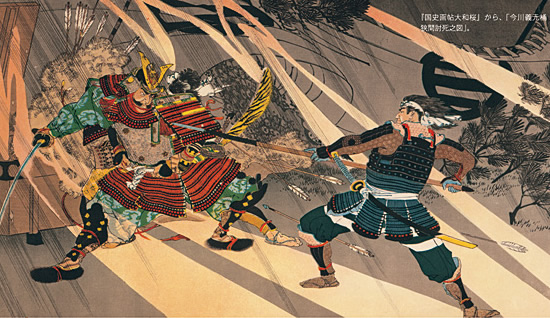|
Musashi grew up in the period between Senkoku Jidai (Warring states period) and Edo Jidai (Tokugawa Shogunate). With the battle of Sekigahara, the role of the gun became firmly entrenched as did the formation of large group tactics to amass firepower. The far reaching consequences would be the eventual replacement of the warrior class with a conscript army trained with rifles. During Senkoku Jidai the Yari or spear and the bow were the primary weapons of the Bushi class. It wasn't the katana as made have sought to believe. The katana therefore, as a personal weapon of choice had a very limited time window historically speaking. It fit well with the concept of Musha Shugyu (austerity training) between the end of the warring states period and the time of the consolidation of power by the Tokugawa.
Musashi lived in a time of great social upheaval. During Senkoku Jidai, people were able to change their stations in life and social caste could be quite fluid. Hideyoshi Toyotomi would be a famous example born a farmers’ son that became a general that set the stage for national unification and the rise of Tokugawa Ieyasu.[1] By the time Musashi’s life had stabilized with a position with a position as a supervisor for the powerful Hosokawa Clan, the Tokugawa were firmly entrenched and had created edicts creating a fixed caste system based upon Japanese Confucianism. These edicts would also limit Musashi's ability to lift his station within society despite his fame. As a retainer of the Hosokawa clan, his yearly stipend was 300 koku or rice.2 --------------------------------------------------------------------------------------------------------------------------------------------- see Buke Shohatto(武家諸法度)based upon Confucian orders that promoted a societal caste system. ---------------------------------------------------------------------------------------------------------------------------------------------- Miyamoto Musashi volunteered to fight in the Shimabara Rebellion, the Tokugawa effort to eradicate the growing interest in Christianity that was seen as a threat with competing loyalties to a foreign religion and to a local lord. Musashi and 19 of his followers went to fight. The defensive positions of the pro-Cristian forces were formidable and the first attack failed. The Tokugawa redoubled their efforts and eventually and ruthlessly crushed the rebellion. Injured when hit by a stone, Musashi withdrew the scene while in transit to the battle, having written a note for and obtaining permission to retire the field. So much for being indestructible in the face of danger. It was Musashi's dying wish that he requested of his lord that he be buried in full armor in a standing position to protect the Hosokawa Clan in the hereafter. This wish was supposedly granted. It is interesting to note that Musashi lived, trained , and dueled without full armor as his station as a low ranking samurai wouldn't warrant full armor. [1] This generalissmo had humble beginnings and became a powerful warlord thru merit. Today when Japanese think of rags to riches success stories, they model themselves after Hideyoshi. [2] One koku of rice was the equivalent of keeping one person alive for a year.
0 Comments
Leave a Reply. |
AuthorRick Categories
All
Archives
January 2017
|
|
Po Box 232 Severna Park, MD. 21146
|
Copyright © 1996 - 2023


 RSS Feed
RSS Feed






